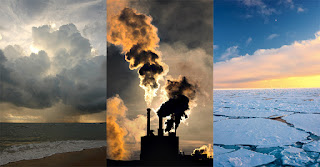 Well, the time has come. The end of the semester is just around the corner, so this will be my final blog for my environment science class. This week’s assignment asked us to look back at everything that we have learned throughout the semester and pick a topic that we think is the most important today, and do some investigation as to why we think that is, So I pick….Climate Change.
Well, the time has come. The end of the semester is just around the corner, so this will be my final blog for my environment science class. This week’s assignment asked us to look back at everything that we have learned throughout the semester and pick a topic that we think is the most important today, and do some investigation as to why we think that is, So I pick….Climate Change.But first I want to talk about the most interesting thing that I learned this semester. That just happened to come on field trip to Amy’s Farm, a small back-to-basics farm in Ontario, CA. I grew up on a ranch, so being there immediately took be back to my childhood. But my childhood didn’t include gardening, but it’s something that Amy’s Farm did. I’ve always been interested in gardening, but I didn’t know much, and I always assumed you had to have A LOT of space. But that’s not always the case. Yes, Amy’s Farm’s garden is much larger than I have at home, but it’s not about the size, it’s about what you plant and how you use land. Before this field trip, I really wasn’t aware that certain plants give and take certain nutrients to the soil, and with the right combination, you can harvest a lot in small spaces. This is something that I came home with, and plan on implementing in my life.
So back to Climate Change:
Human induced Climate changes, like global warming, is changing the world right in front of our very eyes, yet not everyone is on board, and doesn’t see this as an issue. But it is. According to the CEF, “Global warming leads to rising temperatures of the oceans and the earth’ surface causing of polar ice caps, rise in sea levels and also unnatural patterns of precipitation such as flash floods, excessive snow or desertification” (CEF.com). During the 20th century, the Earth’s average temperature increased by 1° Fahrenheit, which doesn’t seem like a lot, but Earth’s climate record shows that small changes in temperature lead to huge changes in the environment. For example, at the end of the last ice age, average temperatures in the united states were only 5-9 degrees cooler than today. Glaciers shrinking, polar ice melting, plant and animal ranges shifting, coral bleaching, floods and heat waves are just the tip of the iceberg. Over the next century, scientists predict the temperature to rise between 2.5 and 10 degrees Fahrenheit with a mean of 1.8 to 5.4°. This is expected to have beneficial impacts in some regions, but have harmful effects in others (nasa.gov)
What can we do about it as a society? –
Education:
As a society, I believe one of the most important things we can do to fight climate change is to support education efforts that help both the individual and communities to make informed decisions. Incorporating climate science into practical knowledge makes understanding a complex subject and making decisions slightly less daunting
Mitigation:
In simple terms, mitigation simply means “righting a wrong”. In this case, the wrong is the emission of greenhouse gasses. Mitigation of greenhouse gas emissions means reducing and conserving oil, gas, and coal, the main fossil fuels, and getting everyone on board is no easy task. “decarbonizing” is necessary for mitigation, this includes finding other sources of energy.
What can you do about it as an individual?
Simple measures all play important roles.
o Plant trees!
o Drive less: biking, carpooling, public transportation
o Buy local food
o Turn off lights, unplug electronics and appliances
o Use energy efficient appliances
o Switch to renewable energy
o Educate yourself
o Advocate
o Recycle
o Purchase fuel efficient car
Sources:
http://climate.nasa.gov/effects/
http://www.conserve-energy-future.com/15-current-environmental-problems.php
http://www.broward.org/POLLUTIONPREVENTION/AIRQUALITY/EDUCATIONALPROGRAMS/Pages/ThingsToPreventClimateChange.aspx















